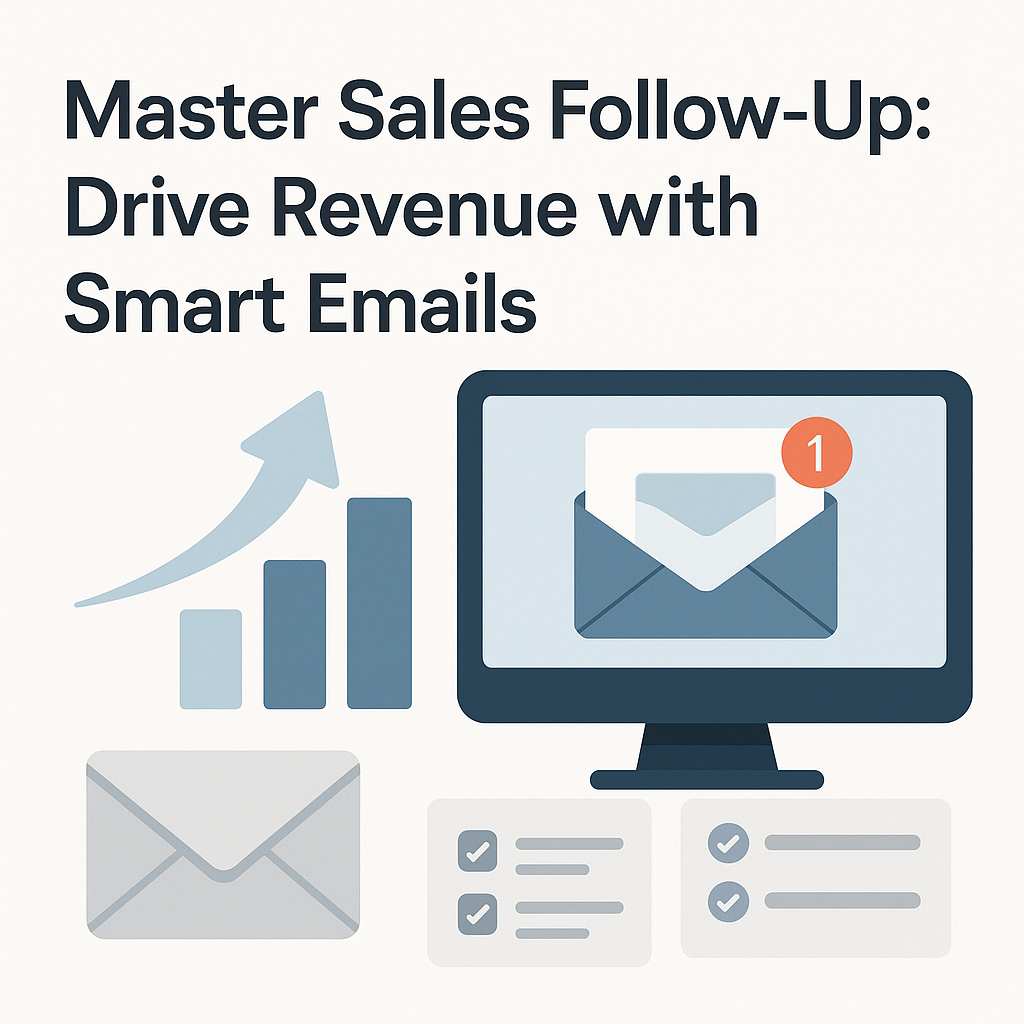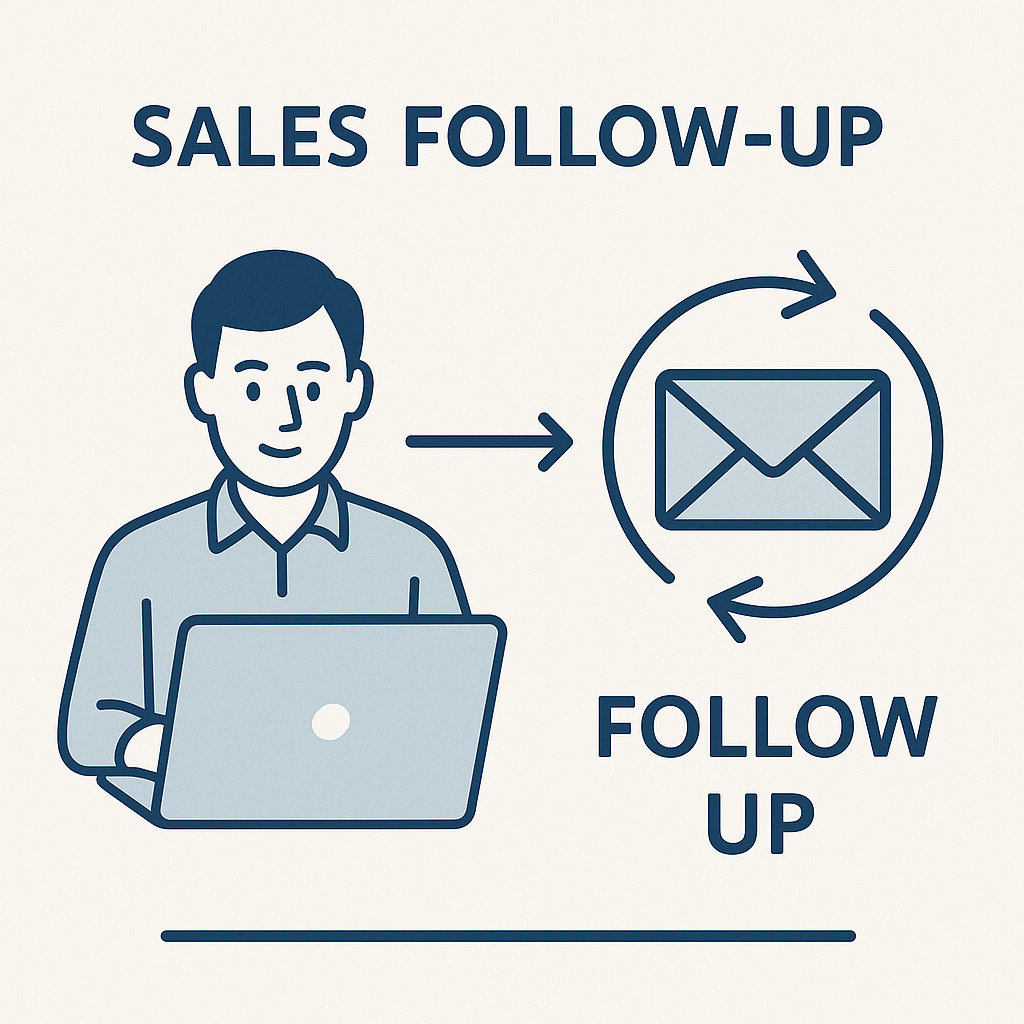Master Sales Follow-Up: Drive Revenue with Smart Emails

Did you know that up to 80% of sales require five or more follow-up attempts? Yet, many sales professionals struggle to maintain consistent and effective outreach. In the fast-paced world of business, the difference between a closed deal and a lost opportunity often boils down to one critical, yet frequently neglected, element: sales follow-up. It's the engine that drives conversions, nurtures relationships, and ultimately, fuels revenue growth. Without a robust follow-up strategy, even the most promising leads can go cold, leaving potential income on the table. This article delves into the art and science of mastering your sales follow-up, specifically through the power of smart emails, and explores how modern tools can transform this essential process.
The Undeniable Link Between Sales Follow-Up and Revenue Growth
In sales, the initial contact is just the first step. The real work of building trust, demonstrating value, and guiding a prospect toward a purchase happens in the subsequent interactions. Effective sales follow-up is not just about persistence; it's about strategic engagement that keeps your offering top-of-mind and addresses the prospect's evolving needs. Statistics consistently show that reps who follow up diligently close more deals. For instance, studies suggest that a significant percentage of sales are made on the fifth to twelfth follow-up contact. This highlights a crucial truth: closing a deal is rarely a one-and-done event. It's a journey, and your follow-up is the vehicle that navigates it.
This consistent engagement is what differentiates successful sales professionals and teams. It's about nurturing the relationship, providing additional value, and subtly reinforcing why your solution is the best fit. Neglecting this crucial stage is akin to planting a seed and then abandoning it before it can grow. The result? Wasted leads, lost revenue, and stalled business growth. Understanding the direct correlation between diligent follow-up and increased revenue is the first step toward optimizing your sales pipeline.
The Pain Points of Manual Sales Follow-Up
The reality for many sales teams is a chaotic inbox, missed follow-up opportunities, and the nagging feeling that potential deals are slipping through the cracks. This isn't a sign of poor effort, but often a symptom of manual processes struggling to keep pace with the demands of modern sales. When you're juggling multiple leads, prospecting, conducting demos, and managing existing clients, dedicating consistent, thoughtful time to each follow-up can feel like an insurmountable task. Several common pain points emerge, significantly impacting your email productivity for sales:
- Time Constraints: Sales professionals are often overwhelmed with tasks. Manually tracking who to follow up with, when, and what to say in each email eats up valuable selling time. This can severely impact your ability to focus on core selling activities.
- Forgetting to Follow Up: In a busy day, a prospect's name can easily slip your mind. Without a robust system, leads fall through the cracks simply because they weren't added to a reminder or a follow-up sequence. This is a primary reason deals go cold.
- Inconsistent Messaging: Manual follow-ups often lack a consistent tone or message. This can confuse prospects and dilute your brand's professionalism, making it harder to build trust.
- Lack of Personalization: While the intent is to be personal, manual follow-ups often end up being generic. Crafting unique messages for each prospect takes significant time and effort, which is often a scarce resource, leading to missed opportunities for deeper connection.
- Difficulty Tracking Engagement: Knowing if your follow-up email was opened, clicked, or ignored is crucial for effective next steps. Manual tracking is often inaccurate or non-existent, leaving you guessing about prospect interest.
- Overcoming Objections: Without a clear strategy for addressing common objections in follow-ups, prospects may remain hesitant, and deals stall indefinitely.
These challenges can lead to a significant drop in conversion rates and hinder overall business development. The good news is that you don't have to operate this way. By learning to reclaim email time and manage your communications more effectively, you can overcome these hurdles and ensure your follow-up efforts are impactful.
Leveraging AI for Smarter Sales Follow-Up Strategies
Fortunately, the landscape of sales outreach automation is being transformed by Artificial Intelligence (AI). AI-powered tools are no longer a futuristic concept; they are essential components for modern sales teams seeking to optimize their sales follow-up processes and drive revenue growth. AI addresses the core pain points of manual follow-up by offering:
- Intelligent Automation: AI can automate the scheduling and sending of follow-up emails based on pre-defined triggers or cadences, ensuring no lead is forgotten. This frees up valuable time for your sales team.
- Data Analysis and Insights: AI can analyze prospect behavior (e.g., email opens, link clicks) and market trends to provide insights into the best times to follow up and what messaging resonates most. This aligns with using AI sales tools for a competitive edge.
- Personalization at Scale: AI can help personalize emails by pulling data from CRM systems, social media, or news articles, allowing for highly relevant messages without manual research for every single outreach.
- Predictive Capabilities: Some AI tools can predict which leads are most likely to convert or when a prospect might be ready to buy, allowing sales teams to prioritize their efforts more effectively and focus on high-potential leads.
- Streamlined Workflow: By automating repetitive tasks, AI frees up sales professionals to focus on higher-value activities like building relationships and closing deals, much like how managing all your follow-up communications from a single platform ensures consistency and organization, as suggested by sources like Emlen.io.
Integrating AI into your sales process means moving from a reactive, manual approach to a proactive, intelligent system. This shift not only improves efficiency but also significantly enhances the quality and effectiveness of your effective sales communication. Tools like advanced AI agents can revolutionize how you manage your entire inbox, making your outreach more targeted and impactful.
Crafting High-Converting Sales Follow-Up Emails: Key Elements
Once you've committed to a consistent follow-up strategy, the next crucial step is ensuring your emails actually convert. Generic, poorly crafted messages will do more harm than good. Effective follow up emails for sales are a blend of strategy, psychology, and clear communication. Here are the key elements to consider when writing your outreach:
1. Compelling Subject Lines
Your subject line is your first impression. It needs to be clear, concise, and intriguing enough to warrant an open. Avoid being overly salesy or generic. Instead, focus on providing value, sparking curiosity, or referencing a shared context. Examples:
- "Quick question about [Prospect's Company Name]'s recent initiative"
- "Following up on our chat about streamlining your [Specific Process]"
- "Resource for overcoming [Prospect's Stated Pain Point]"
- "Your thoughts on [Previous Discussion Point]?"
Using personalization, like the prospect's name or company, can also boost open rates significantly.
2. Value Proposition in Every Interaction
As highlighted by sales experts, such as those at MemoryBlue, "Each follow-up should offer something beneficial to the client, whether it’s insightful information, helpful resources, or answers to their queries. Avoid repetitive messages that offer no new value." This means each email should aim to educate, inform, or solve a problem for the prospect. This could be a link to a relevant blog post, a case study, an industry report, or a quick tip related to their challenges. Consistently providing value builds trust and positions you as a helpful resource.
3. Personalization Beyond the Name
Generic emails get deleted. Personalized messages get read and acted upon. Leverage information you've gathered about the prospect's company, their role, their industry, and their specific pain points. Reference recent company news, a LinkedIn post they shared, or a specific challenge they mentioned in your last conversation. This shows you've done your homework and genuinely care about their success, moving beyond superficial engagement.
4. Clear and Concise Messaging
Respect your prospect's time. Get straight to the point. Your email should be easy to scan and understand. Use short paragraphs, bullet points, and bold text to highlight key information. Avoid jargon and overly technical language unless you are certain your prospect will understand and appreciate it. Clarity is key to ensuring your message is received and understood.
5. A Strong Call to Action (CTA)
What do you want the prospect to do after reading your email? Make it clear. Your CTA should be specific and easy to execute. Examples include:
- "Would you be available for a quick 15-minute call next week to discuss this further?"
- "Please let me know if you have any questions or if there's anything else I can provide."
- "Click here to download the case study we discussed."
Having well-crafted follow up email templates can be a powerful tool in your arsenal, as emphasized by resources like LeadSimple. These templates allow you to maintain consistency and efficiency while still personalizing messages to each prospect.
Best Practices for Sales Follow-Up Cadence and Timing
Establishing a consistent sales email cadence is vital. Bombarding a prospect is counterproductive, but waiting too long between touches allows them to forget about you or move on to a competitor. The optimal cadence depends on your industry, the complexity of your product, and the prospect's engagement level, but here are some general best practices:
- Initial Follow-Up: Send a follow-up within 24-48 hours after the initial contact or demo. Reiterate key points and provide any requested information.
- Subsequent Follow-Ups: Space out subsequent emails by 2-4 business days. Each email should offer new value, address potential objections, or ask a targeted question that encourages a response.
- Vary Your Channels: Don't rely solely on email. Incorporate phone calls, LinkedIn messages, or even direct mail if appropriate. This multi-channel approach increases touchpoints and engagement across different platforms.
- Use Intent Data: Arm yourself with accurate information and intent data on your lead before you approach them, as recommended by sales strategy guides like RevBoss. This helps tailor your message and timing. Knowing when a prospect is actively researching solutions similar to yours can inform your follow-up strategy and make your outreach more relevant.
- Track Engagement: Monitor open rates, click-through rates, and reply rates. If a prospect isn't engaging with your emails, it might be time to change your approach, segment them differently, or consider if they are a good fit.
- Know When to Stop: Not every lead will convert. It's important to have a defined point at which you stop pursuing a lead to avoid wasting resources. A common practice is to stop after 6-8 attempts over a period of several weeks, unless there's a clear indicator of renewed interest.
Managing all your follow-up communications from a single platform ensures consistency and organization, making it easier to maintain this crucial cadence and track your progress effectively.
Personalization at Scale: Making Every Follow-Up Count
In today's crowded marketplace, generic follow up emails for sales simply don't cut it. Prospects expect communication tailored to their specific needs, challenges, and interests. The challenge for sales professionals is achieving this deep level of personalization across dozens, or even hundreds, of leads simultaneously. This is where technology, particularly AI, becomes indispensable for effective customer relationship management email.
Personalization at scale involves leveraging data to make each interaction feel unique and relevant. This can include:
- Leveraging CRM Data: Ensure your CRM is up-to-date with prospect information, including their industry, company size, pain points, previous interactions, and any specific notes from sales calls. This forms the foundation for personalized outreach.
- Utilizing Sales Intelligence Tools: Tools that provide AI sales tools for competitor intelligence or market trends can offer valuable insights that you can weave into your follow-up messages. For example, if a prospect's company just announced a new funding round or launched a new product, you can reference this in your email to show you're paying attention and that your message is timely and relevant.
- Behavioral Triggers: If a prospect visits a specific page on your website (e.g., pricing page, a product feature page), you can trigger a follow-up email that addresses that specific interest, making your outreach highly contextual.
- Dynamic Content: Some email platforms allow for dynamic content insertion, where specific blocks of text or offers change based on recipient data, ensuring each email feels custom-tailored.
By mastering personalization at scale, you move beyond transactional communication to build stronger, more meaningful relationships. This fosters trust and significantly increases the likelihood of conversion, making your sales efforts far more effective.
Automating Your Sales Follow-Up with MailToPie
The sheer volume of tasks required for effective sales follow-up can quickly overwhelm even the most organized sales professional. This is where intelligent automation becomes a game-changer for improving email productivity for sales. Tools like an ai executive assistant can help streamline your workflow by managing your sales outreach automation and ensuring that every prospect receives timely, relevant communication without manual intervention.
MailToPie, for example, is designed to enhance the daily workflow of sales professionals by automating repetitive tasks, managing follow-up sequences, and providing smart reminders. Imagine a system that:
- Automates Email Sequences: Set up multi-step email campaigns that are triggered by specific actions or dates. If a prospect doesn't reply to the first email, the system automatically sends a follow-up after a set period, with a different message or approach designed to re-engage them.
- Schedules Follow-Ups: Automatically schedule your follow-up emails weeks or months in advance, ensuring consistent touchpoints without manual calendar management or risk of forgetting.
- Provides Smart Reminders: Get intelligent prompts when it's time to follow up with a specific lead based on their engagement or your pre-set cadence, ensuring you never miss a crucial touchpoint.
- Manages Your Pipeline: Integrate with your CRM to keep track of prospect status and ensure follow-up activities align with deal stages, maintaining a clear overview of your sales pipeline.
- Optimizes Messaging: Some AI tools can even help suggest improvements to your email copy or subject lines based on performance data, helping you refine your approach over time.
By leveraging such tools, you can ensure that your sales follow-up is not just consistent but also highly optimized for engagement and conversion. This level of automation is key to scaling your sales efforts efficiently and effectively, allowing you to focus on building relationships and closing deals.
Consider how an ai executive assistant can transform your daily workflow, ensuring that critical tasks like follow-ups are never missed. This is crucial for maintaining momentum in your sales pipeline and driving predictable revenue growth.
Conclusion: Master Your Follow-Up, Master Your Sales Pipeline
In the competitive landscape of modern sales, mastering sales follow-up is not optional – it's essential for survival and growth. The consistent, personalized engagement that effective follow-up provides is what builds lasting customer relationships, overcomes objections, and ultimately, drives revenue. We've explored the common pitfalls of manual follow-up, from time constraints to forgotten leads, and highlighted how leveraging AI and intelligent automation can transform these challenges into opportunities.
By implementing smart strategies for crafting compelling follow up emails for sales, establishing an optimal sales email cadence, and committing to personalization at scale, you can significantly improve your conversion rates. Tools like an ai executive assistant are invaluable allies in this endeavor, offering the power to automate, organize, and optimize your outreach. When you master your follow-up, you don't just close more deals; you build a more robust, predictable, and profitable sales pipeline.
Start by assessing your current follow-up process. Identify your biggest pain points and explore how AI-powered solutions can provide the structure and efficiency you need. The investment in smart follow-up strategies is an investment in your company's future revenue and sustained success. Don't let valuable opportunities slip away – make your follow-up work smarter, not harder.



